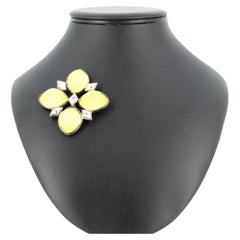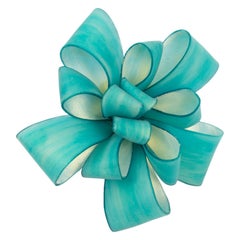Jeanne Lanvin Brooches
The career of Jeanne Lanvin (1867–1946) and her eponymous brand began with a millinery apprenticeship in the late 19th century. Today, Lanvin Paris is a globally revered company and is among the oldest French fashion houses still in existence. It is renowned for its exquisite and sought-after vintage evening dresses, shoes, skirts and other garments and accessories and for having dressed such high-profile celebrities as Meryl Streep, Natalie Portman, Kim Kardashian and Sienna Miller.
In 1889, when her apprenticeship came to an end, the young French designer Jeanne Lanvin opened a custom hat shop on the rue Boissy d’Anglas in Paris. Four years later, she moved her business into a much more prominent space on the rue du Faubourg Saint-Honoré, one of the world’s most famous luxury fashion districts.
The new Maison Lanvin was big enough to display the pieces she would design for her daughter, Marguerite, who was born in 1897. The relationship between Lanvin and her daughter would be at the core of the brand, with a 1907 photograph of Jeanne and Marguerite in matching outfits inspiring the fashion house’s enduring logo.
In 1908, Lanvin launched a line of children’s clothing, one of the first such moves in high-end fashion. When mothers came in to buy the clothes, they often asked for similar designs for themselves.
Lanvin decided to introduce a women’s wear line with pieces that had a youthful femininity. This would grow to encompass everyday clothing, dresses, coats, lingerie and furs, as well as menswear, perfume and household items. Once she became a member of the Chambre Syndicale de la Couture (Parisian Fashion Council) in 1909, her title officially switched from milliner to designer.
Along with her stylish designs, Lanvin identified the importance of brand identity through fabric colors, opening a dye factory in Nanterre, France. There the distinctive “Lanvin blue” was produced, so even if her designs were copied, the colors could never be exactly reproduced.
After Jeanne Lanvin's death, her daughter, Marguerite Marie-Blanche de Polignac, took over and a series of talented artistic directors would propel the brand through the trends of the 20th century, including Jules François Crahay, Dominique Morlotti, Alber Elbaz and, most recently, Bruno Sialelli.
In 2018, Lanvin was acquired by the Fosun Fashion Group, which is now focused on celebrating Lanvin’s heritage while pushing it into a new chapter.
Find vintage Jeanne Lanvin evening dresses, jackets and other clothing on 1stDibs.
21st Century and Contemporary Jeanne Lanvin Brooches
Silver
1950s American Art Nouveau Vintage Jeanne Lanvin Brooches
Gold Plate
Early 2000s French Modern Jeanne Lanvin Brooches
1870s English Victorian Antique Jeanne Lanvin Brooches
Yellow Gold
1970s French Modernist Vintage Jeanne Lanvin Brooches
1930s American Art Deco Vintage Jeanne Lanvin Brooches
Diamond, Platinum
1950s American Vintage Jeanne Lanvin Brooches
Crystal, Gold Plate, Base Metal
Late 20th Century Unknown Jeanne Lanvin Brooches
Coral, Diamond, Emerald, Ruby, 18k Gold
1950s French Artisan Vintage Jeanne Lanvin Brooches
Bronze, Gilt Metal, Gold Plate, Brass
1980s French Romantic Vintage Jeanne Lanvin Brooches
Gilt Metal
1950s French Medieval Vintage Jeanne Lanvin Brooches
Bronze
1960s German Art Deco Vintage Jeanne Lanvin Brooches
Gold Plate
1970s German Vintage Jeanne Lanvin Brooches
Jeanne Lanvin brooches for sale on 1stDibs.
Creators Similar to Jeanne Lanvin
- What did Jeanne Lanvin create?1 Answer1stDibs ExpertMarch 21, 2024Jeanne Lanvin created dresses and gowns, men’s collections, lingerie, hats, children’s clothing, fragrances and more. The legendary French designer founded her namesake luxury house in the late 19th century.
Today, Lanvin is a globally revered company and is among the oldest French fashion houses still in existence. It is renowned for its exquisite and sought-after vintage evening dresses, shoes, skirts and other garments and accessories and for having dressed such high-profile celebrities as Meryl Streep, Natalie Portman, Kim Kardashian and Sienna Miller. Find vintage Lanvin clothing and accessories on 1stDibs. - 1stDibs ExpertMarch 21, 2024To pronounce Jeanne Lanvin, say “zhhuAHWNN LAWW-vuh.” When pronounced properly, the very beginning of Jeanne should sound like the end of the words “collage” (kuh-LAAZH) or “massage” (muh-SAAZH). The end of Jeanne sounds as if you’re exaggerating or adding emphasis to the “AAHN” sound at the end of the name “John.”
Today, Lanvin, which was founded in the late 19th century by designer Jeanne Lanvin, is a globally revered company and is among the oldest French fashion houses still in existence. Shop vintage Lanvin bags, clothing and accessories from some of the world’s top boutiques on 1stDibs.


